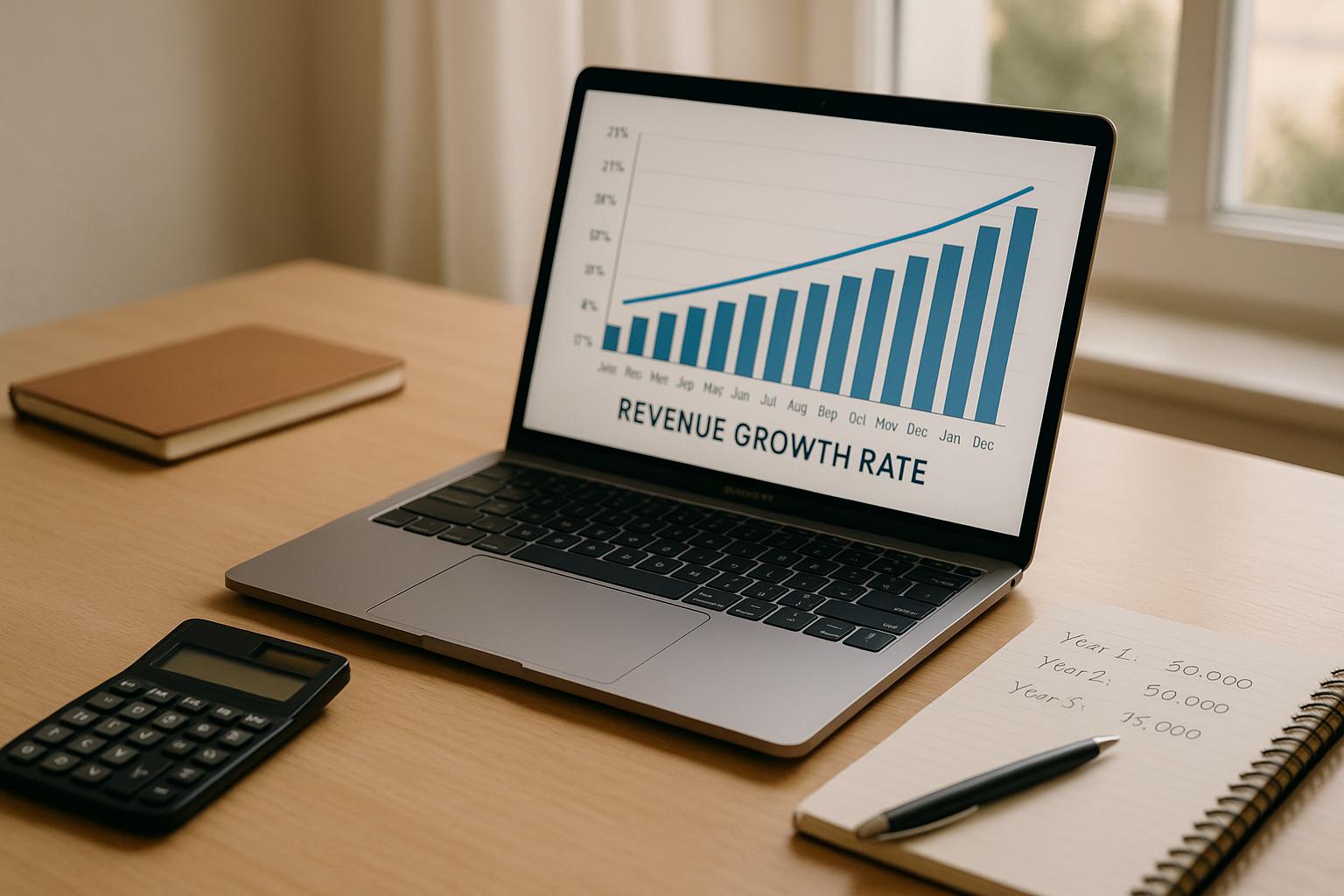How to Integrate Data for SaaS Dashboards

Integrating data for SaaS dashboards can help unify metrics like MRR, ARR, churn, and CAC, making it easier to track performance and make decisions. Here's how to do it effectively:
- Map Your Data Sources: Identify key systems like financial tools (Stripe, PayPal), CRMs, and user analytics platforms.
- Set Goals: Align KPIs with business objectives and ensure data accuracy with validation rules.
- Use APIs: Connect data sources in real-time, manage authentication, and resolve issues like rate limits or data mismatches.
- Implement ETL/ELT: Extract, transform, and load data efficiently using tools with features like schema detection and error handling.
- Automate Updates: Keep dashboards current with scheduled updates and automation tools.
- Secure Your Data: Apply encryption, role-based access, and multi-factor authentication to protect sensitive information.
This step-by-step approach ensures your SaaS dashboards are accurate, efficient, and secure, enabling better decision-making and streamlined operations.
1. Map Your Data Sources and Goals
To create a unified SaaS dashboard, start by identifying your key data sources and setting clear goals. Understanding your data landscape and objectives is essential before diving into system integration.
Key Data Source Categories
A well-designed dashboard pulls information from essential data sources, including:
Financial Systems
- Payment processors like Stripe and PayPal
- Accounting platforms
- Banking tools
- Expense management software
Customer Data
- CRM platforms
- Support ticketing systems
- User analytics tools
- Email marketing software
Product Usage
- Application databases
- Tools for tracking user behavior
- Metrics for feature adoption
- Performance monitoring systems
Each source should contribute to your core metrics, laying the groundwork for a clear integration plan.
Setting Integration Goals
To align your integration efforts with your business objectives, focus on these areas:
Analyze Historical Data
Start by reviewing your existing data to assess current performance. This provides a baseline for tracking progress and spotting trends. Use these insights to set realistic goals and growth expectations.
Align KPIs with Business Goals
Translate your company’s vision into measurable metrics. Introduce weekly reviews to ensure that all teams are working toward shared objectives.
"PSG saved my dream. They helped us get our financials in order and renegotiate our lending agreements, pulling us through a tough financial crunch." - Norman Rodriguez, Founder / CEO, ElevateHire
Establish a Data Processing System
Create systems that operate efficiently without constant supervision. Focus on:
- Automating data pipelines
- Defining clear validation rules
- Performing regular accuracy checks
- Setting up error notifications
When designing your integration strategy, prioritize the data sources that directly influence your most critical business decisions. This approach keeps your efforts focused and prevents unnecessary data overload while ensuring you have visibility into the metrics that matter most.
2. Connect Through APIs
How APIs Work
APIs allow software systems to communicate and exchange data in real time. Most modern APIs rely on REST architecture to:
- Automatically request and update data
- Use consistent data formats
- Manage secure authentication
- Facilitate standardized data transfers between systems and dashboards
API Setup Steps
- Identify Available APIs
Check the documentation for your data sources to locate API endpoints that offer access to:
- User data
- Transaction records
- Usage statistics
- System performance metrics
- Set Up Authentication
- Generate API keys
- Configure OAuth 2.0 tokens
- Enable IP whitelisting
- Define rate limiting rules
- Map Data Fields
Outline the required metrics and conversions, set update schedules, and establish error-handling protocols to ensure smooth data mapping.
Fix Common API Issues
Rate Limiting
Track API usage and implement request queuing to avoid hitting limits. Set up alerts to notify you when you're nearing thresholds.
Data Sync Problems
Ensure data consistency by:
- Comparing record counts
- Manually validating key metrics
- Logging sync operations
- Running automated health checks
Connection Timeouts
Use retry logic with exponential backoff and create failover connections to handle timeouts effectively.
Data Format Mismatches
Standardize data formats to avoid errors. Focus on:
- Dates
- Currency values
- Text fields
- Handling of null values
| Common API Issue | Impact | Solution |
|---|---|---|
| Rate Limiting | Service interruptions | Use request queuing and monitoring |
| Data Sync Problems | Inconsistent metrics | Perform validation checks and logging |
| Connection Timeouts | Failed updates | Apply retry logic with backoff |
| Format Mismatches | Invalid data | Use standardized transformations |
Regularly reviewing API documentation and maintaining detailed integration logs can help you avoid disruptions. These practices ensure stable connections, laying the groundwork for real-time insights and efficient ETL processes - which we’ll cover in the next section.
3. Set Up ETL/ELT Processing
ETL/ELT Basics
ETL (Extract, Transform, Load) and ELT (Extract, Load, Transform) are essential for integrating data into SaaS dashboards. ETL transforms data before loading it into a destination, while ELT uses modern cloud data warehouses to handle transformations after loading. This allows for more flexibility in handling large datasets.
Here’s a quick comparison:
| Process | Data Flow | Ideal For | Speed |
|---|---|---|---|
| ETL | Transform before loading | Sensitive data needing cleanup | Slower initial load |
| ELT | Transform after loading | Large datasets requiring fast access | Faster initial load |
| Hybrid | Combination of both | Complex dashboard needs | Varies by setup |
These processes work alongside API integrations to ensure smooth data operations.
Choose ETL Tools
ETL tools simplify how you prepare and manage data. They often include features like:
- Automated Schema Detection: Maps fields and relationships automatically.
- Built-in Connectors: Pre-configured links to common data sources.
- Data Quality Checks: Ensures clean and accurate data.
- Version Control: Tracks changes in transformation logic.
When picking an ETL tool, consider:
- Scalability: Can it handle increasing data loads?
- Transformation Features: Does it offer built-in cleaning functions?
- Monitoring: Does it provide real-time alerts for errors?
- Cost: Compare pay-per-use vs. fixed pricing models.
Build ETL Workflows
With the right tools in place, design workflows that prioritize speed and accuracy. Follow these steps:
-
Define Data Quality Rules
Set clear validation criteria, such as acceptable value ranges, required formats, relationship integrity, and duplicate detection. -
Create Transformation Logic
Outline specific steps to clean and standardize data, like currency conversions, date format adjustments, unit standardization, and aggregation rules. -
Implement Error Handling
Plan for common issues like validation failures, connection errors, transformation glitches, and loading problems. -
Set Performance Metrics
Track metrics like processing time, error rates, data freshness, and resource usage. For better performance, schedule heavy transformations during off-peak hours to reduce system strain while keeping data up-to-date.
This approach ensures your dashboards remain efficient and reliable.
sbb-itb-e766981
4. Enable Automated Updates
Once you've set up effective ETL workflows, automation ensures your dashboards always display the most up-to-date information.
Why Automate
Automating updates minimizes manual work and reduces the risk of errors. Here are some key advantages:
- Fewer Errors: Cuts down on typos and formatting mistakes.
- Consistent Updates: Ensures all components refresh on schedule.
- Timely Data: Keeps metrics current and accessible.
- Better Resource Use: Frees up your team to focus on strategy and analysis.
Live Data Updates
Real-time synchronization ensures your dashboards stay current. To make this work, set up reliable pipelines and schedule updates carefully to prevent system overload. Automation connects your integrated data pipelines to live dashboards, ensuring your insights are always based on the latest data. The next step? Choose the right automation tool for your needs.
Automation Software Options
The best automation tool for you will depend on factors like data volume, integration complexity, and your organization's specific needs. Here are some popular pricing plans to consider:
| Plan | Price | Description |
|---|---|---|
| Basic Plan | $96/year | Ideal for up to 10 users, offering essential automation features. |
| Business Plan | $192/year | Includes advanced features, detailed reporting, and enhanced workflow tools. |
| Enterprise Plan | $384/year | Provides custom support and enterprise-level security for larger teams. |
When starting out, focus on automating your most important KPIs. Keep an eye on how automation impacts system performance, and gradually expand to include more data sources. This step-by-step approach allows for testing and fine-tuning as your dashboard grows.
If you're looking for expert help in setting up reliable, automated data pipelines, Phoenix Strategy Group offers data engineering services to ensure your SaaS dashboard runs smoothly and scales effectively.
5. Protect Your Data
Keeping your data secure is crucial when working with sensitive information.
Data Management Rules
Start with strong data management practices. This includes classifying your data and defining clear access rules. Use version control to manage changes and maintain detailed audit trails. These trails help track edits, spot issues, and ensure compliance with data protection laws. Once governance is in place, focus on implementing secure systems effectively.
Security Measures
A layered approach is key to protecting your data. Here are some essential security practices:
- End-to-end encryption for both data in transit and at rest.
- Role-based access control (RBAC) to restrict data visibility based on user roles.
- Multi-factor authentication to add an extra layer of security for all users accessing your dashboard.
For larger data environments, Phoenix Strategy Group offers data engineering services that integrate enterprise-level security. They also streamline ETL pipelines, ensuring your security systems grow alongside your data needs.
Wrapping It Up
Creating effective SaaS dashboards starts with integrating data systematically. This means mapping out your data sources, setting clear goals, and establishing reliable API connections along with ETL/ELT workflows. Automated updates ensure your dashboards stay relevant, while strong security measures safeguard sensitive information. This setup allows for ongoing improvements to your dashboard's performance.
The key to success lies in balancing functionality and security. With strong security practices in place, organizations can protect their data while keeping operations running smoothly.
Professional data engineering plays a crucial role in this process. For example, Phoenix Strategy Group's team specializes in building secure ETL pipelines and implementing scalable, enterprise-level security solutions. Their expertise highlights the importance of maintaining vigilant and scalable integration methods.




